Starting with insects, the smallest of embroidered motifs and following on with animals and birds, all that is left to look at in detail on my jacket are the 8 flowers, although as one of them is a fruit, the pomegranate, and 2 are more or less fantastical, I ‘m obviously using the term flower rather liberally. At 18, I suspect I chose the flowers purely from considerations of shape and colour and with only a minimal concern for historial accuracy. Recently looking into whether this is true reveals the following…
ROSE
This is of course the red rose of Lancaster, the emblem of Henry VII, Elizabeth I’s grandfather. As “any fule kno” (to quote Nigel Molesworth, eternal schoolboy) after the Basttle of Bosworth Field, 1485, the white rose of York was superimposed upon the red rose of Lancaster to symbolise the union by marriage of the two dynastic families at the end of the Wars of the Roses.
Elizabeth chose as her own device a different rose, the eglantine or briar rose, a flower with pale pink petals fading to white towards the centre from which plentiful yellow stamens rise. Many portraits of Elizabeth show her with this rose and in some cases, for example the Phoenix Jewel in the British Museum, Tudor roses and eglantines appear together. Elizabeth liked the eglantine for its gentle flower and sturdy prickles which perfectly symbolised a certain British toughness. In a masque staged for her at Theobalds in 1591, a character says of the eglantine, “The deeper it is rooted in the ground, the sweeter it smelleth in the flower, making it ever so green that the sun of Spain at the hottest cannot parch it”, a reminder of England’s defeat of the Spanish Armada only 3 years before. Oh well, I used the wrong rose, but as Gertrude Stein said, “a rose is a rose is a rose”.
CARNATION
Why on earth I have embroidered navy blue and turquoise carnations I have no idea.
In the C16th carnation was also the name of a colour – a pale red to deep blush pink. Then the word pink was not used to describe a colour but referred to fancy cutting of fabric in pretty zig zags, an effect very like the edge of carnation petals. It seems likely that the word pink slipped from being a description of this ornamental ragged effect to another name for the flower itself and then slid one step further to apply to the characteristic colour of the flower. It is only some 200 years later, in the C18th, that pink came into regular use as the name of a colour. The use of pink in its original sense is just about hanging on today in pinking shears, the serrated edged scissors used to cut the edge of fabric to prevent it from fraying.
Today carnations seem unfashionable, probably because they are victims of their own success in the cut flower trade. In a bunch of mixed flowers bought from a supermarket or garage forecourt, it is the carnations that go on long after the others have dropped and for some reason we seem to love them a little less for this. Fashion will no doubt turn again and I’d like to think that students at Oxford University are doing a little towards this as a new tradition has arisen which shows every likelihood of flourishing. For the first university exams (usually, but not always at the end of the first year) academic dress is livened up with a white carnation and for the last set of exams, a red. A pink carnation indicates exams in between. One carnation should last through the exam period. The tradition must predate 2006 as that was when the Oxford Carnations website was set up by students to ensure supplies were sufficient (and also presumably to make a profit). If anyone knows any more, do get in touch. In my day, the most exciting thing to happen to academic dress was the occasional individual turning up in black velvet hotpants…but then that was a long time ago when there were no mixed colleges… I think I’ll leave it at that.
PANSY
The pansy was Elizabeth I’s favourite flower and stood for a chaste spirit which symbolism the Virgin Queen was very happy to encourage. As she grew ever older, her perceived chastity was the only positive aspect of the fact that the ageing monarch was never going to produce an heir. But the pansy was a quiet symbol amid some very noisy ones. For example, the Rainbow Portrait (at Hatfield House) bursts forth with all sorts of symbolism and blatant propaganda most of which isn’t in the least subtle. Shown holding a rainbow (the traditional symbol of peace going back to biblical origins), the queen wears a cloak painted with eyes and ears to indicate she hears and see many things (through her courtiers) but with the implications that she uses her own judgement . Completely covering the voluminous fabric of her left sleeve are the coils of a jewelled serpent from whose mouth trails a gold chain at the end of which is a pendant ruby heart, while above the serpent’s head hangs a celestial sphere. The serpent is to be read as a symbol of wisdom, through which she rules the passions of her heart, while the armillary sphere above indicates her competence in the affairs of the universe (an explanation taken from Roy Strong in ‘Gloriana :The Portraits of Queen Elizabeth I’, T&H 1987). But it is touching that amid all this larger than life symbolism on loudspeaker and in technicolour, the queen in quieter mode wears a lovely bodice finely embroidered with her favourite flowers – pansies, honeysuckles, carnations and cowslips. If you look at many portraits of the queen the lowly pansy can usually be found lurking somewhere.
CORNFLOWER
Centaurea cyanus takes its botanical name from the legend of Chiron the centaur. Poisoned by an arrow dipped in the hydra’s blood, Chiron covered his wounds with the lowly cornflower growing nearby. Recovering, he attributed his good fortune to the healing properties of the humble flower. Christians upped the symbolism a bit more and from being the enemy of snakes, the cornflower advanced to being the enemy of the biggest snake of all – the Devil, which meant that the cornflower then stood for Christ.
Cornflowers appear regularly in Elizabethan embroidery perhaps surprisingly because at this time it had come to symbolise celibacy – scarcely what a lovely nubile young woman would want to have emblazoned on her bodice. For the queen, however, this was spot on. We often think of chastity in narrow terms as meaning either simply, not being married, or abstinence from sexual intimacy for reasons of religious vows. But the meaning often goes further than this and relates to an individual giving up carnal pleasures to help focus on spiritual growth, and ultimately personal empowerment .Vows of chastity need not be lifelong and at this time were often made for limited periods. So wearing a cornflower would be rather like suggesting ‘don’t mess with me’.
Incidental to all the above, in England now, in early November we are wearing poppies in our lapels to remember the Armistice of 11 November 1918. In France, however, it is the cornflower that is the symbolic flower, Le Bleuet de France. Same fields of battle and two nations pick different flowers. Fascinating. How have I got so far in life and not known this?
POMEGRANATE
Embroidered pomegranates always show the fruit at the point of ripeness. The previously tough case has split open and the little garnet seeds have yet to burst forth in all their profusion.
The Elizabethans would have known the pomegranate was the personal device of Katherine of Aragon. The Moors had introduced the fruit to Spain and after they were thrown out of the country the fruit was adopted as one of their devices by Ferdinand and Isabella, Katherine’s parents. When she married Prince Arthur of England it was natural that Katherine should adopt so distinctive a symbol to take to a foreign country where the fruit was little known. Katherine’s subsequent marriage to Henry VIII saw their symbols, the Tudor rose and the pomegranate conjoined.
Katherine and Henry’s marital difficulties are succinctly described in a small embroidery of 1529 by Anne Boleyn’s mother in which Anne’s symbol, the falcon, is depicted picking at Katherine of Aragon’s split pomegranate. Ouch, this is embroidery with the cut and thrust of a Private Eye cartoon and somehow more wounding for being made in a less transient medium than paper.
Katherine’s daughter, Mary I, then took over the symbol in memory of her mother. You might expect Elizabeth to have had enough of the pomegranate by the time she came to the throne. Indeed there is triumphalism in Elizabeth’s Armada portrait of 1588 where what looks like a pomegranate sits in front of an open window through which you can clearly see the Spanish fleet routed and in disarray. But by 1599, the ‘Hardwick’ portrait from Nicholas Hilliard’s workshop shows a couple of plump pomegranate fruits among all the other painted motifs clearly visible on the lower right of her dress.
HONEYSUCKLE
The honeysuckle was very popular in elizabethan gardens where it was encouraged to twine over trellises, lovers’ bowers and covered walkways to ensure its sweet scent pervaded the air. I devoted two posts of May 2012 (here and here) to the honeysuckle and there I mentioned that it was the emblem for love and marriage, the ties that bind.
At some point in their relationship Anne Boleyn and Henry VIII adopted the honeysuckle and the acorn as a private motif and it can be seen decorating palace ceilings and furnishings, including a carpet at Hampton Court Palace. As Elizabeth was the daughter of Anne Boleyn it seems likely the honeysuckle woud have had a special significance for her too.
JACOBEAN FLOWER – IRIS?
In the case of this flower and the next, my jacket has tipped over into the reign of James I when the style became known as Jacobean and was characterised by ever more fanciful variations on floral themes. Leaves and petals were shown convoluted and curled as they scrolled their way across the fabric. Whereas early Elizabethan flowers were very flat and solid, the Jacobean flower fell irresistibly to the lure of the curve and the style pushed the poor flower, and especially the leaf, to the point at which floral became forest.
If this is based on any real flower at all, it is probably the Iris.
JACOBEAN FLOWER: DAHLIA?
The dahlia is a native plant of Mexico. The first European to describe it was Francisco Hernandez, physician to Philip II of Spain who was sent to Mexico by his king to study the country’s flora and fauna. This raises the interesting possibility that the dahlia could have been brought over to Europe and even to England by Philip when he married Queen Mary. Could have, but probably wasn’t because it doesn’t seem to be recorded as being in Europe until the late C18th.
The first dahlia were flat open-faced flowers. I think I have depicted a pom pom dahlia and I suspect this is a modern variant. So if it’s not a dahlia, it’s fantasy – as the strange leaves suggest.
For 4 weeks I’ve relived making my jacket and scrutinising my needlework. I’ve trawled through websites for historic houses, major museums, obscure online letters and documents, historic gardening and herbal history and some rather zany on line ruminations. I’ve learnt a lot but feel almost as exhausted as sewing it all over again would have made me, so now it’s time to get back to using a needle, the most relaxing occupation I can think of.

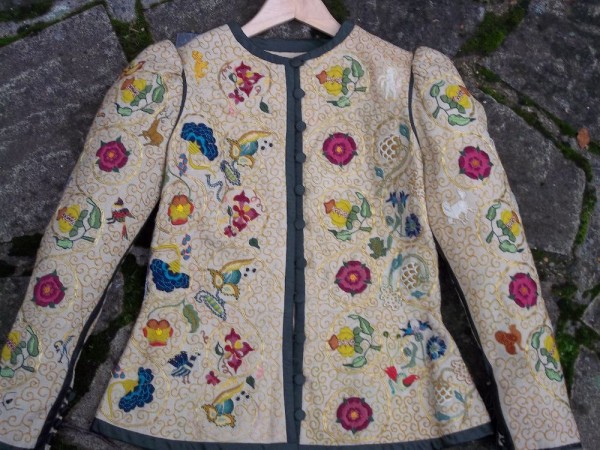
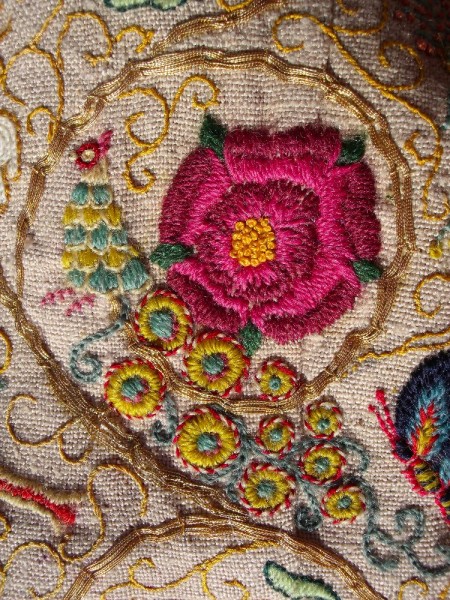
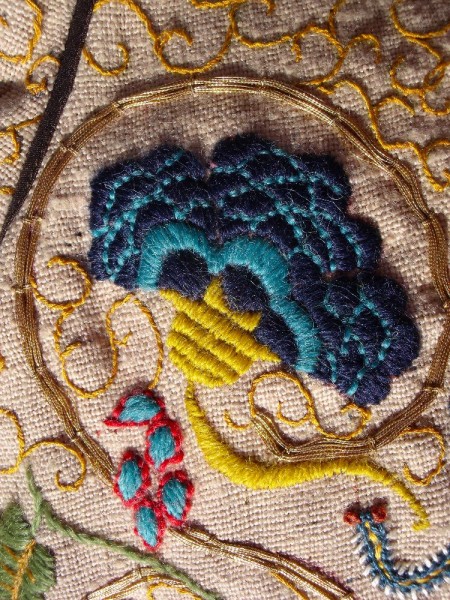
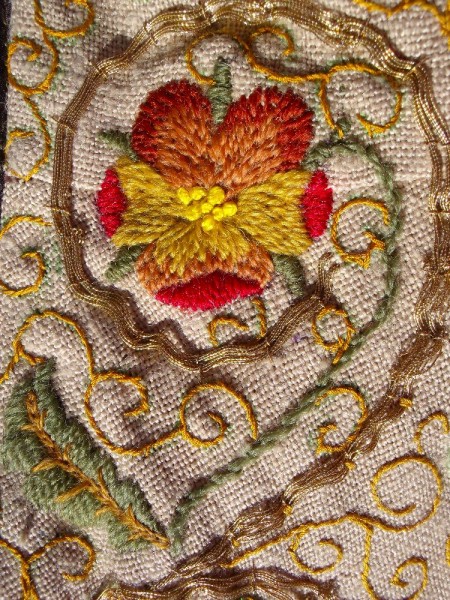
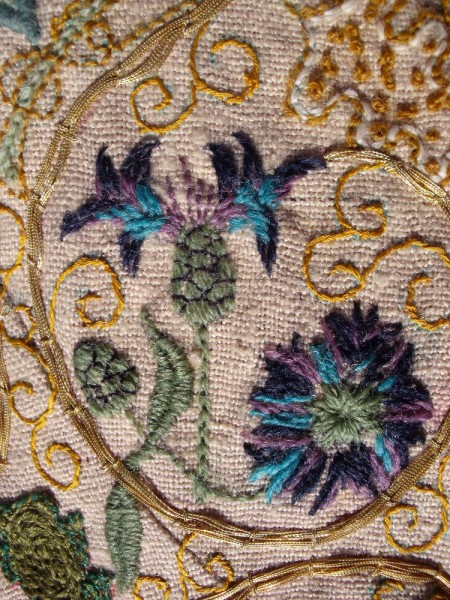
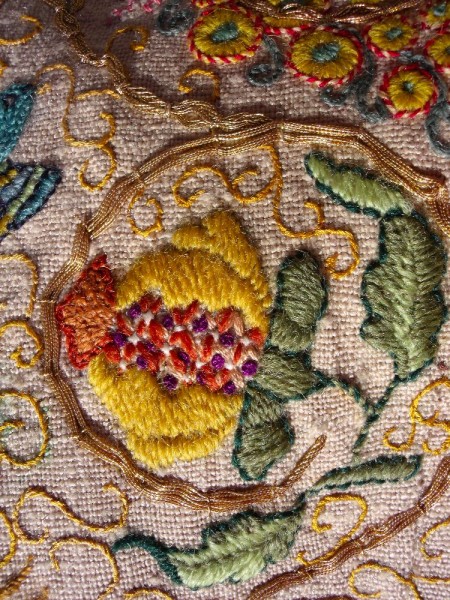
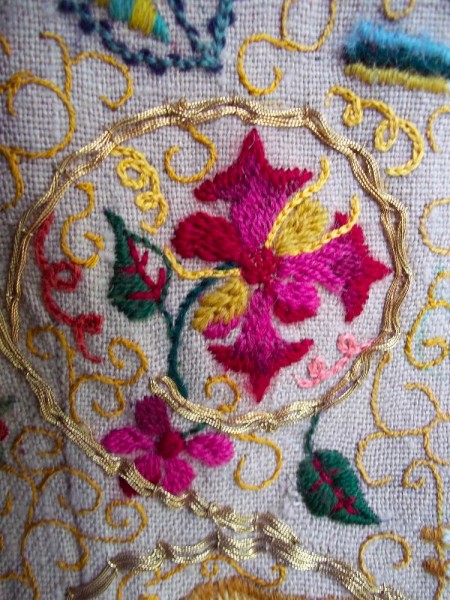
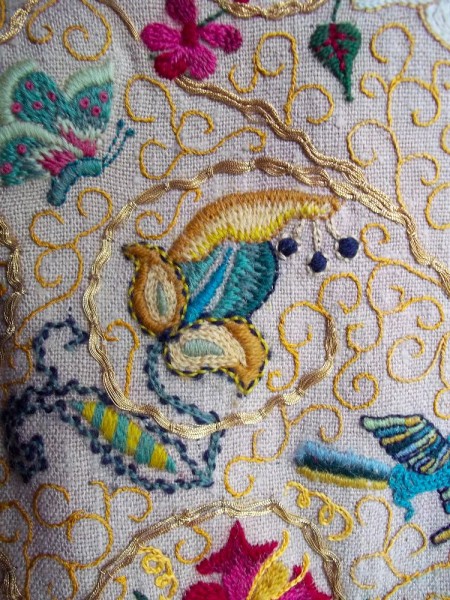
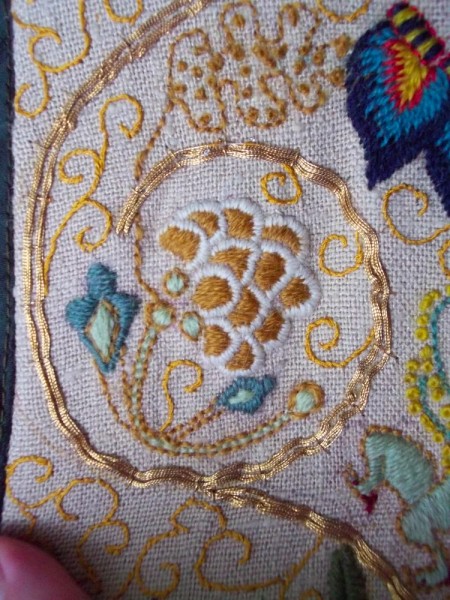
5 Comments
Hi Mary. Great post, thanks for sending me the link. Interesting to note the changes in design between the reigns of Elizabeth I and James I, to what we know as Jacobean today. I love all the symbolism depicted in the embroidery of the day. I wonder what we’d pick as our private motifs? Something to ponder while stitching… Kelly
Kelly,
So sorry not to have replied but for some reason your comment didn’t get flagged up where they usually do and I missed it until I had need to refer back to this post. Grrr.
These jackets are an endless source of fascination for their rich and subtle differences in design. I’ve been thinking about what I might pick as my private motif and I have to say I’m completely stumped. It’s difficult to think of one symbol by which I’d like to be recognised or perhaps I’m just too indecisive?
Hope all goes well with your forthcoming workshop as I’m sure it will because your designs rely on a good strong line and make a real impact.
Gosh what fantastic embroidery – very inspiring. Thank you
Glad you like it. Thank you for such a lovely comment.
In Williamsville, New York, proper insulation is crucial due to the city’s varied climate and the need for energy efficiency.
Insulation Depot USA provides top-notch insulation services,
including attic insulation, wall insulation, and spray foam insulation,
ensuring homes and businesses in neighborhoods like Elmwood
Village and North Buffalo are well-insulated and comfortable year-round.
The importance of reliable insulation cannot be overstated in Williamsville, where temperatures can fluctuate significantly, making energy-efficient insulation critical for
reducing energy costs and maintaining a comfortable indoor environment.
Insulation Depot USA is located in Williamsville,
a city founded in 1850. Williamsville is a historic village with a population of 5,483 as of 2022 and 2,
502 households. The city is conveniently connected by Interstate
190, a major highway that facilitates easy travel to and from the area.
An interesting fact about Williamsville is that it
was originally a water mill town, contributing significantly to the region’s early industrial development.
Today, Williamsville offers a blend of residential, commercial, and recreational
opportunities, making it an attractive place to
live and work.
The cost of insulation repairs and installations in Williamsville can vary depending on the type of service required.
Basic services like attic or wall insulation might range from $1,000 to $3,000, while
more extensive work such as spray foam insulation or insulation removal can cost between $2,000 and $5,000.
Williamsville experiences a wide range of temperatures, with summer highs reaching around 80°F and winter lows dropping to approximately 20°F.
These temperature variations necessitate reliable and efficient insulation to ensure homes remain comfortable and energy-efficient
throughout the year.
Williamsville boasts numerous points of interest that cater to a variety of tastes and preferences.
Niagara Falls is one of the most famous natural wonders in the world,
attracting millions of visitors each year.
The Buffalo and Erie County Botanical Gardens offer a stunning display of plant life in beautiful conservatories.
The Buffalo Zoo, one of the oldest in the country, provides a fun and
educational experience for families. The Albright-Knox Art Gallery showcases an impressive
collection of modern and contemporary art. Lastly, Canalside is a vibrant waterfront district with a variety of activities, including boating,
concerts, and festivals. Each of these attractions offers unique experiences that
highlight the cultural and natural heritage of the region.
Choosing Insulation Depot USA for insulation services in Williamsville is a wise decision for residents and businesses seeking reliable and efficient solutions.
The company offers a comprehensive range of services, including insulation installation, soundproofing, and thermal insulation. Insulation Depot USA’s commitment to quality workmanship and exceptional customer service ensures that all insulation needs are met promptly and professionally.
For those living in Williamsville, Insulation Depot USA
is the trusted partner for maintaining an energy-efficient and comfortable living environment, providing
peace of mind and comfort throughout the year.
In Williamsville, New York, maintaining proper insulation is crucial
due to the city’s changing seasons and the need for
energy efficiency. Insulation Depot USA offers essential insulation services such as attic insulation,
wall insulation, and blown-in insulation, ensuring homes and businesses
in neighborhoods like South Buffalo and West Side stay warm in the
winter and cool in the summer. The significance of having
a reliable insulation contractor in Williamsville cannot be overstated,
as proper insulation is vital for reducing energy costs
and maintaining a comfortable indoor environment throughout the
year.
Insulation Depot USA operates in Williamsville, a city founded in 1850.
Williamsville is a historic village with a population of 5,483 as
of 2022 and 2,502 households. The city is well-connected by Interstate 190, a
major highway that facilitates easy travel across the region. An interesting fact about Williamsville
is its origin as a mill town, which played a significant role in the early industrial development of the area.
Today, Williamsville is known for its charming blend of residential, commercial,
and recreational opportunities, making it a great place to live and work.
The cost of insulation repairs and installations in Williamsville can vary widely depending on the
type of service required. Basic services like attic or wall insulation might
range from $1,000 to $3,000, while more extensive work such as spray foam insulation or
insulation removal can cost between $2,000 and $5,000. Williamsville experiences a range of temperatures, with summer highs reaching around 80°F and winter lows dropping to
approximately 20°F. These temperature variations necessitate
reliable and efficient insulation to ensure homes remain comfortable
and energy-efficient throughout the year.
Williamsville offers numerous points of interest that cater to a variety of tastes and preferences.
The Buffalo and Erie County Botanical Gardens provide a stunning display of plant life in beautiful conservatories.
The Buffalo Zoo, one of the oldest in the country,
offers a fun and educational experience for families.
The Albright-Knox Art Gallery showcases an impressive collection of
modern and contemporary art. Canalside is a vibrant waterfront district with a variety of activities, including boating,
concerts, and festivals. The Buffalo Museum of Science offers engaging exhibits and educational programs for all ages.
Each of these attractions offers unique experiences
that highlight the cultural and natural heritage of the
region.
Choosing Insulation Depot USA for insulation services in Williamsville is a wise decision for residents and businesses seeking reliable and efficient solutions.
The company offers a comprehensive range of services, including insulation installation, soundproofing, and thermal
insulation. Insulation Depot USA’s commitment to quality workmanship and exceptional customer service
ensures that all insulation needs are met promptly and
professionally. For those living in Williamsville, Insulation Depot USA is the trusted
partner for maintaining an energy-efficient and comfortable living environment,
providing peace of mind and comfort throughout the year.
In Williamsville, New York, proper insulation is essential due to the city’s varied climate and the need for energy efficiency.
Insulation Depot USA provides top-notch insulation services, including attic insulation, wall insulation,
and spray foam insulation, ensuring homes and businesses in neighborhoods like Allentown and Downtown Buffalo are well-insulated and comfortable year-round.
The importance of reliable insulation cannot be overstated in Williamsville, where temperatures can fluctuate significantly, making energy-efficient
insulation critical for reducing energy costs and maintaining a comfortable indoor
environment.
Insulation Depot USA is located in Williamsville, a city founded
in 1850. Williamsville is a historic village with
a population of 5,483 as of 2022 and 2,502 households. The city is conveniently connected by Interstate
190, a major highway that facilitates easy travel to and from the
area. An interesting fact about Williamsville is its historical significance
as a mill town, contributing to the region’s early industrial development.
Today, Williamsville offers a blend of residential, commercial, and recreational opportunities, making it an attractive place to live and
work.
The cost of insulation repairs and installations in Williamsville
can vary depending on the type of service required. Basic
services like attic or wall insulation might range from $1,000 to $3,
000, while more extensive work such as spray foam insulation or insulation removal can cost
between $2,000 and $5,000. Williamsville experiences a wide range of
temperatures, with summer highs reaching around 80°F and winter lows dropping to approximately 20°F.
These temperature variations necessitate reliable and efficient insulation to ensure homes remain comfortable and energy-efficient throughout the
year.
Williamsville boasts numerous points of interest that cater to a variety
of tastes and preferences. Niagara Falls is one of the most famous natural wonders in the world, attracting millions of visitors each year.
The Buffalo and Erie County Botanical Gardens offer a stunning display of plant life in beautiful conservatories.
The Buffalo Zoo, one of the oldest in the country,
provides a fun and educational experience for families.
The Albright-Knox Art Gallery showcases an impressive collection of modern and contemporary art.
Lastly, Canalside is a vibrant waterfront district with a variety of activities,
including boating, concerts, and festivals.
Each of these attractions offers unique experiences that highlight the cultural and
natural heritage of the region.
Choosing Insulation Depot USA for insulation services in Williamsville is a
wise decision for residents and businesses seeking reliable and efficient
solutions. The company offers a comprehensive range of services, including insulation installation, soundproofing, and thermal insulation. Insulation Depot USA’s commitment
to quality workmanship and exceptional customer service ensures that all insulation needs are met promptly and professionally.
For those living in Williamsville, Insulation Depot USA is the
trusted partner for maintaining an energy-efficient and comfortable living environment,
providing peace of mind and comfort throughout the
year.
In Williamsville, New York, maintaining proper insulation is crucial due to the city’s changing seasons and the need for
energy efficiency. Insulation Depot USA offers essential insulation services such as attic
insulation, wall insulation, and blown-in insulation, ensuring homes and businesses
in neighborhoods like East Side and Black Rock stay warm in the winter and cool in the summer.
The significance of having a reliable insulation contractor in Williamsville cannot be overstated, as proper insulation is vital for reducing
energy costs and maintaining a comfortable indoor environment throughout the year.
Insulation Depot USA operates in Williamsville, a city founded in 1850.
Williamsville is a historic village with a population of 5,483 as of 2022 and 2,502 households.
The city is well-connected by Interstate 190, a major highway that facilitates easy travel
across the region. An interesting fact about Williamsville
is its origin as a mill town, which played a significant role in the early industrial development of
the area. Today, Williamsville is known for its charming blend of residential, commercial, and recreational
opportunities, making it a great place to live and work.
4 Trackbacks
[…] to embroidered single flowers still obviously recognisable botanically (as on my Elizabethan jacket here) through to the sort of fantastical foliage imagined above. Along with bigger and more elaborate […]
[…] To learn more about flowers the Elizabethans loved see what I wrote about my embroidered Elizabethan jacket’s flowers here. […]
[…] little ones so loved by florists and often to be seen at summer weddings. The one I embroidered on my Elizabethan jacket is, I think a more domesticated variant – altogether bigger and brasher, with big thick […]
[…] Here is a little pink I embroidered some time ago for the altar frontal and for text I refer you to my musings on the flower in my post on my Elizabethan jacket. […]